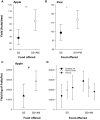In-hive learning of specific mimic odours as a tool to enhance honey bee foraging and pollination activities in pear and apple crops
- PMID: 36443327
- PMCID: PMC9705528
- DOI: 10.1038/s41598-022-22985-5
In-hive learning of specific mimic odours as a tool to enhance honey bee foraging and pollination activities in pear and apple crops
Abstract
The areas devoted to agriculture that depend on pollinators have been sharply increased in the last decades with a concomitant growing global demand for pollination services. This forces to consider new strategies in pollinators' management to improve their efficiency. To promote a precision pollination towards a specific crop, we developed two simple synthetic odorant mixtures that honey bees generalized with their respective natural floral scents of the crop. We chose two commercial crops for fruit production that often coexist in agricultural settings, the apple (Malus domesticus) and the pear trees (Pyrus communis). Feeding colonies with sucrose solution scented with the apple mimic (AM) or the pear mimic (PM) odour enabled the establishment of olfactory memories that can bias bees towards the flowers of these trees. Encompassing different experimental approaches, our results support the offering of scented food to improve foraging and pollination activities of honey bees. The circulation of AM-scented sucrose solution inside the hive promoted higher colony activity, probably associated with greater activity of nectar foragers. The offering of PM-scented sucrose solution did not increase colony activity but led to greater pollen collection, which is consistent with pear flowers offering mainly pollen as resources for the bees. Results obtained from apple and pear crops suggest that the offering of AM- and PM-scented sucrose solution increased fruit yields. This preliminary study highlights the role of in-hive olfactory learning to bias foraging preferences within pome fruit crops.
© 2022. The Author(s).
Conflict of interest statement
National Scientific and Technical Research Council of Argentina (CONICET) has the intellectual property (Pat. 20110102441) on the commercial use of the apple formulation to improve honey bee pollination efficiency, in which W.M.F., A.A., and P.C.D. are coinventors. National Scientific and Technical Research Council of Argentina (CONICET) and the University of Buenos Aires have filed the patent application (PCT/IB2018/055550) on the commercial use of the pear formulation to improve honey bee pollination efficiency, in which W.M.F. and P.C.D. are coinventors. W.M.F. is coinventor and shareholder of ToBEE S.A., the licensee of this technology. C.S.M. and M.J.C. declare no competing interests.
Figures





References
-
- Potts, S. G., Ngo, H. T., Biesmeijer, J. C., Breeze, T. D., Dicks, L. V., Garibaldi, L. A., Hill, R., Settele, J., & Vanbergen, A. The Assessment Report of the Intergovernmental Science-Policy Platform on Biodiversity and Ecosystem Services on Pollinators, Pollination and Food Production (Secretariat of the Intergovernmental Science-Policy Platform on Biodiversity and Ecosystem Services, 2016).
-
- Isaacs R, Williams N, Ellis J, Pitts-Singer TL, Bommarco R, Vaughan M. Integrated Crop Pollination: Combining strategies to ensure stable and sustainable yields of pollination-dependent crops. Basic Appl. Ecol. 2017;22(2017):44–60. doi: 10.1016/j.baae.2017.07.003. - DOI
Publication types
MeSH terms
Substances
LinkOut - more resources
Full Text Sources
Medical

